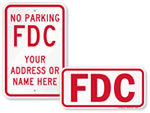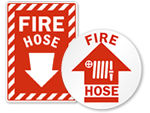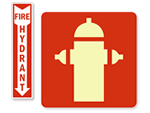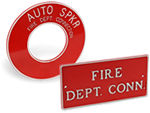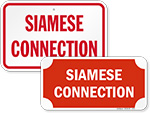Every year in the United States, businesses lose billions of dollars on damages caused by fire. Firefighters respond to over 100,000 commercial and business fire incidents yearly. The lack of fully compliant signs marking the fire department connections can mean several extra minutes in getting to the equipment at a time.
When it comes to fire safety, businesses must not settle for anything less than premium, highly conspicuous signage that is durable for years.

What are FDC signs?
FDC signs are visual markers for the first responders, informing them about the location of the fire department connection in and around a building or facility.

Image source: Nfpa.org
Fire Department Connections, abbreviated as FDC and also known as the “siamese connection,” are used to attach a fire hose and pump water into the building's standpipe system amplifying the water pressure to the building's sprinkler system in case of additional water requirement during a fire outbreak.
Why are FDC Signs important?
FDC signs are crucial for commercial facilities in more ways than one:
Easy Identification
A lot of times, landscaping such as trees, berms, boulders, heavy equipment, pallets, and dumpsters block the way of the exterior fire department connection (FDC). Firefighters may sometimes be unaware of buildings and the area. Signs prove indispensable (not wrong, but more common with “to be” in between) in directing the firefighters to FDCs during emergencies.
Save Time
Signs help firefighters quickly locate the FDC and expedite the rescue operation without letting the fire spread.
Compliance
FDC signs are important because they are required by the fire and building codes like the IBC and NFPA 14. Section 912 of the IBC contains requirements on the location, inlet fire hose threads, access, and signage for the FDC.
What kind of facilities require FDC Signs?
FDC signs are required in all facilities with a fire department connection. Model codes enforced by organizations specify where FDC and other fire protection systems are required. The premise for these systems is based on the user groups, height, and whether the structure is classified as a high-rise building (over 75 feet tall). NFPA 13R, NFPA 13, and NFPA 14, all require FDC in all structures, with a few exceptions. Having said that,(remove, should only be used when you’re saying something that counters your previous sentence. Your previous sentences also highlight the importance of FDC signs ie They do a really great job. Having said that, they can be messy when they work.) FDC signs play a major role at:
- - Big box stores
- - Office buildings
- - Warehouses
- - Distribution centers
- - Restaurants
- - Airport hangers
- - Apartment buildings
FDC signs may be of lesser use for very small buildings, remote buildings that are inaccessible to the fire service, or large open-sprinkler deluge systems that exceed the pumping capability of the fire service.
What are the official requirements regarding FDC Signs?
Businesses must review applicable fire codes and consult the community’s fire department to determine specific FDC signage requirements. Custom FDC signs can be used to display any specific information and comply with laws.
International Building Code
IBC [Section 912.2.2] clearly states that “on existing buildings, wherever the fire department connection is not visible to approaching fire apparatus, the fire department connection shall be indicated by an approved sign mounted on the street front or on the side of the building.”
The letters “FDC” shall at least be 6 inches in height. Other words or the directional arrow on the sign shall at least be 2 inches in height.

IBC [Section 912.5] requires a metal sign with raised letters not less than 1 inch on all FDCs connected to automatic sprinklers, standpipes, or fire pump connections. The sign shall read AUTOMATIC SPRINKLERS or STANDPIPES or TEST CONNECTION or a combination of thereof to tell firefighters where the water goes—to a fire sprinkler system, standpipe system, or both.
The standard also clearly states that "where the fire department connection does not serve the entire building, a sign shall be provided indicating the portions of the building served."
NFPA 13
NFPA 13 requires FDCs to have -
- - A plate or fitting with raised or engraved letters at least 1 inch tall identifying the system (2022 edition of NFPA 13, section 16.12.5.8.1)
- - Signs indicating the pressure required to fully supply the system with water, except when the pressure is less than 150 PSI
- - Signage telling firefighters what part of the building an FDC serves—if it serves only part of a building

NFPA 14
NFPA 14 just requires a sign with letters at least 1? high. Like the NFPA 13 rules, the sign must -
- - indicate the system served (“STANDPIPE,” “STANDPIPE AND AUTOSPKR” or “AUTOSPKR AND STANDPIPE”)
- - In addition, signs for manual standpipe systems must “indicate that the system is manual and that it is either wet or dry”
- - All standpipe systems need a sign indicating the pressure required “at the inlets to deliver the standpipe system demand”
- - If the FDC serves multiple structures or locations, a sign must provide that information
Like NFPA 13 and 14, state fire codes may have additional requirements for FDC Signs like stating the type of system the connection supplies (standpipe system or sprinkler system), the level of water pressure that the connection requires, and whether the connection supplies just a portion or to the entire building.
Does OSHA have requirements for marking and signage of FDC?
Although not a standard, OSHA does advise employers to have FDC signs that help firefighters quickly locate FDCs. Signs are especially helpful where the FDC is on a building set back from the street. The following are major requirements mentioned in OSHA’s manual ‘Fire Service Features of Buildings’ which are advisory in nature:
- - Signs must provide information about the system FDC feeds (type, coverage, and design).
- - Additional FDC signage is warranted for underground buildings such as transit system facilities.
- - FDC signs are required for systems that are not interconnected — to clearly indicate which FDC feeds which system(s).
- - Signage must be available for firefighters to make it clear which FDC corresponds to which building. This can occur when free-standing FDCs are located far from the buildings they feed.
- - Signage must also help when FDCs feed a building with several addresses.
What are the safety rules businesses often violate regarding FDC?
The following are the common FDC violations that businesses must refrain from:
Blocked FDCs and valves
Immediate access to fire department connections shall be maintained at all times and without obstruction by fences, bushes, trees, walls, or any other fixed or moveable object.
FDC testing
NFPA 25 requires hydrostatic testing of FDCs every five years to ensure the piping that connects it to the standpipe system and/or the piping in the fire suppression system can withstand the pressure applied by the fire apparatus.
What happens if the FDC sign is missing?
Lives can be lost if FDC signs are missing or if FDCs are blocked by vehicles, tractor-trailers, trash bins, boulders, berms, pallets, or landscaping. FDC signs make way for firefighters and allow quick and easy access at all times. Property owners and managers must use necessary signage and clear the way to provide the required access.
Not installing an FDC sign may constitute a fire code violation, the penalty for which may differ from state to state. Property owners or managers may face legal consequences along with penalties. In Maine, for example, the fire code violation penalties range from $100 to $2500, depending on the severity of the offense and willingness to correct it. Noncompliant businesses are granted a 30-day grace period to fix anything, not in compliance with.















